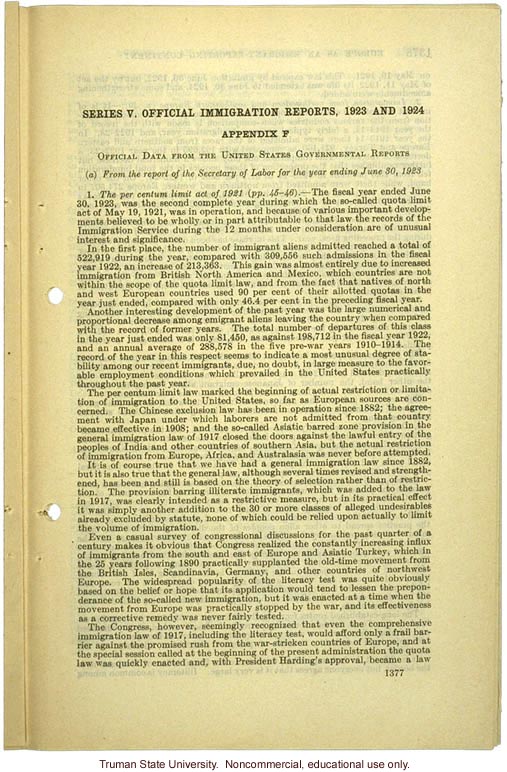"Europe as an emigrant-exporting continent," Harry H. Laughlin testimony before the House Committee, including Immigration Restriction Act (8)

"Europe as an emigrant-exporting continent," Harry H. Laughlin testimony before the House Committee, including Immigration Restriction Act (8)
1148. Series V. Official Immigration Reports, 1923 and 1924 Appendix F Official Data from the United States Governmental Reports (a) From the report of the Secretary of Labor for the year ending June 30, 1923 1. The per centum limit act of 1921 (pp. 45-46). - The fiscal year ended June 30, 1923, was the second complete year during which the so-called quota limit act of May 19, 1921, was in operation, and because of various important developments belieced to be wholly or in part attributable to that law the records of the Immigration Service during the 12 months under consideration are of unusual interest and significance. In the first place, the number of immigrant aliens admitted reached a total of 522,919 during the year, compared with 309,556 such admissions in fiscal year 1922, an increase of 213,363. The gain was almost entirely due to increased immigration from British North America and Mexico, which countries are not within the scope of the quota limit law, and from the fact that natives of north and west European countries used 90 per cent of their allotted quotas in the year just ended, compared with only 46.4 per cent in the preceding fiscal year. Another interesting development of the past year was the large numerical and proportional decrease among emigrant aliens leaving the country when compared with the record of former years. The total number of departures of this class in the year just ended was only 81,450, as against 198,712 in the fiscal year 1922, and an annual average of 288,578 in the five-year pre-war years 1910-1914. The record of the year in this respect seems to indicate a most unusual degree of stability among our recent immigrants, due, no doubt, in large measure to the favorable employment conditions, which prevailed in the United States practically throughout the past year. The per centum limit law marked the beginning of actual restriction or limitation of immigration to the United States, so far as European sources are concerned. The Chinese exclusion law has been in operation since 1882; the agreement with Japan under which laborers are not admitted from that country became effective in 1908; and the so-called Asiatic barred zone provision in the general immigration law of 1917 closed the doors against the lawful entry of the peoples of India and other countries of southern Asia, but the actual restriction of immigration from Europe, Africa, and Australia was never before attempted. It is of course true that we have had a general immigration law since 1882, but is it also true that the general law, although several times revised and strengthened, has been and is still based on the theory of selection rather than of restriction. The provision barring illiterate immigrants, which was added to the law in 1917, was clearly intended as a restrictive measure, but in its practical effect it was simply another addition to the 30 or more classes of alleged undesirables already excluded by the statute, none of which could be relied upon actually to limit the volume of immigration. Even a casual survey of congressional discussions for the past quarter of a century makes it obvious that Congress realized the constantly increasing influx of immigrants from the south and east of Europe and Asiatic Turkey, which in the 25 years following 1890 practically supplanted the old-time movement from the British Isles, Scandinavia, Germany, and other countries of northwest Europe. The widespread popularity of the literacy test was quite obviously based on the belief or hope that its application would tend to lessen the preponderance of the so-called new immigration, but it was enacted at a time when the movement from Europe was practically stopped by the war, and its effectiveness as a corrective remedy was never fairly tested. The Congress, however, seemingly recognized that even the comprehensive immigration law of 1917, including the literacy test, would afford only a frail barrier against the promised rush from the war-stricken countries of Europe, and at the special session called at the beginning of the present administration the quota law was quickly enacted and, with President Harding's approval, became a law 1377
- ID: 11127
- Source: DNALC.EA


